A Journey Though Ellesmere Island’s Historic Landscapes |
The road less travelled through the Canadian arctic leads directly to Ellesmere Island. Positioned across a narrow channel from northwestern Greenland, the island was inhabited by Inuit as early as 2000 B.C. but abandoned as a hunting ground half a millennium ago. In more recent times – a mere century ago – the island served as the staging area for a series of tragic and then, ultimately, triumphant efforts by explorers scrambling to reach the North Pole. The remnants of that historic race have been well-preserved by the polar climate, and at above 80 degrees of northern latitude, reside within a rarely visited world of glaciers, pack ice and polar bears.
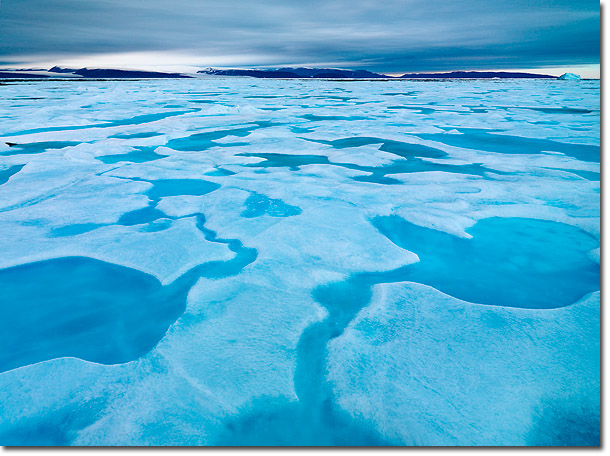
Arctic Oasis, Kennedy Channel / Hasselblad H3D-39, HC 28mm
Although Ellesmere is the tenth largest island on Earth, its location and climate deter all but a few hundred visitors each year. This summer I managed to become one of those visitors, reaching its shores aboard a Russian icebreaker, with the goal of photographing its exceptional landscapes. Along the way, though, one could scarcely avoid becoming engrossed in the history that animates the land. Having struggled for days through deep ice aboard a modern, 24,000 horsepower, steel-reinforced ship, it was difficult to fathom how early explorers even considered traversing the same waters. Yet during an expedition undertaken between 1908 and 1909, Robert Peary, undeterred by the failure of his predecessors, eventually succeeded in his quest for the pole. His achievements remain among those most revered in the history of exploration.
Toward the northern end of Ellesmere Island sits Fort Conger, 81o 45’ N, an outpost from which Peary launched many of his expeditions. The icebreaker on which I travelled became only the second ship in the last 70 years to reach that station. There a shelter erected by Adolphus Greeley and then renovated by Peary in 1899 remains standing, surrounded by piles of glassware, cans, stoves and other artifacts abandoned by the early explorers. Greeley was a U.S. Army officer sent to make scientific observations in 1881, whose mission took a catastrophic turn when a resupply ship failed to arrive. He and his 26 men faced 250 days of winter, equipped with only 40 days of food. They were reduced to boiling and consuming their own leather clothing, and eventually, to eating each other. Only seven survived. Fortunately, both the cuisine and the survival rate on my voyage were far superior.
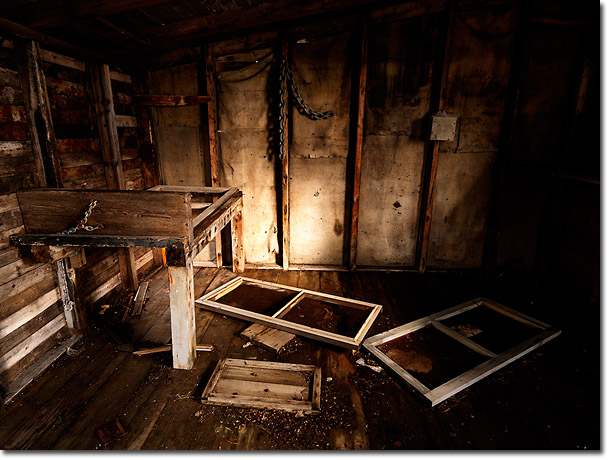
Royal Canadian Mounted Police Outpost, Dundas Harbor at Devon Island (1924) / Hasselblad H3D-39, HC 28mm
Normally I endeavor to exclude manmade elements from my imagery, and that was the plan from the outset of this journey. However, as I worked through the dingy, rubble-filled, dimly lit ruins deserted a century ago, the story they told was brought to life. Hopefully the resulting images will convey some sense of the conditions with which early explorers struggled while crossing the landscapes that began as my primary photographic subject.
Sea Ice
In transit between sites of historical interest, my attention returned to capturing the pristine arctic wilderness – landscapes defined, at least for now, by snow and ice. Each winter the surface of the Arctic Ocean forms a new layer of ice between one and three meters thick. When this so-called “young ice” does not melt during the summer months, it forms thicker and harder multi-year ice. Like miniature tectonic plates, sheets or pancakes of ice are also often pushed together, resulting in even heavier and more intricate conglomerations. While these ice patties may not sound terribly interesting, they proved to be fascinating photographic subjects, particularly when their patterns aligned to form leading lines, and when complimented by arctic weather and golden light. Also decorating the pack ice, and frequently contributing vital structure and color, were brilliant blue pools and streams of meltwater.
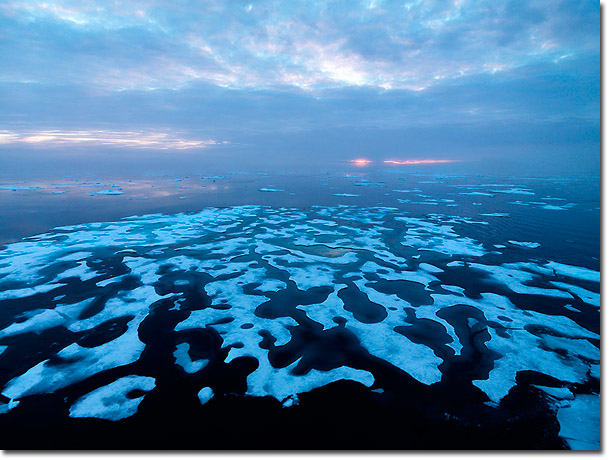
Jigsaw Pack Ice / Hasselblad H3D-39, HC 28mm
Icebergs
Pack ice and icebergs are, of course, entirely different animals. Calved from glaciers, often many tens of meters thick, and frequently containing dense blue ice hardened over hundreds of years, icebergs pose a serious threat even to steel-plated icebreaking ships. Indeed, earlier this year an ice shelf more than four times the size of Manhattan broke free from the Peterman Glacier in northwestern Greenland, just across from Fort Conger. Though Greenland seems to generate the largest icebergs in the region, Ellesmere Island, one third of which is covered by an ice cap reaching 900 meters thick, produces its share of terrestrial ice as well.
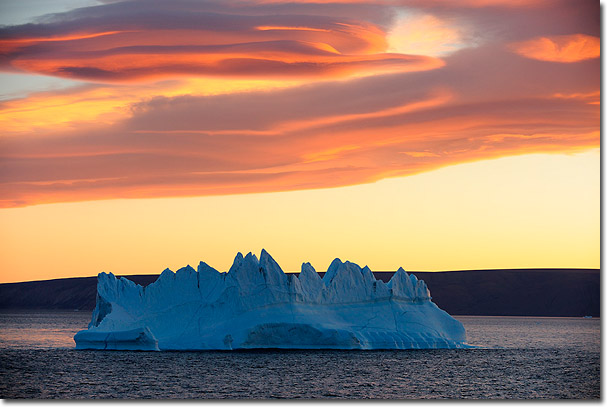
Ice Castle Under Midnight Sun / Nikon D700, 70-200mm at 102mm
Icebergs are thankfully not just cold and dangerous creatures; they are works of art. These floating ice sculptures make superb subjects to photograph, particularly in late evening or early morning light. They are also, in my opinion, often most attractive when only a small amount of polarization is employed, emphasizing reflections over submerged underbellies, although there is plenty of room for experimentation in this regard.
Weather
As a serious photographer, I was undoubtedly less pleased than most of my fellow passengers with the weather we encountered. Day after day brought clear blue skies and unseasonably temperate conditions – the antithesis of what one usually looks for in arctic landscape imagery. Absent the icebergs and a chill in the air (temperatures hovered around 0 degrees C), I might regularly have wondered whether I had been transported back to California. Thankfully, thick blankets of fog did appear on several occasions, softening the midnight sun and setting the stage for several of my favorite photographs from the expedition. Shrouded in mist, backlit gardens of ice turned out to be surprisingly picturesque.
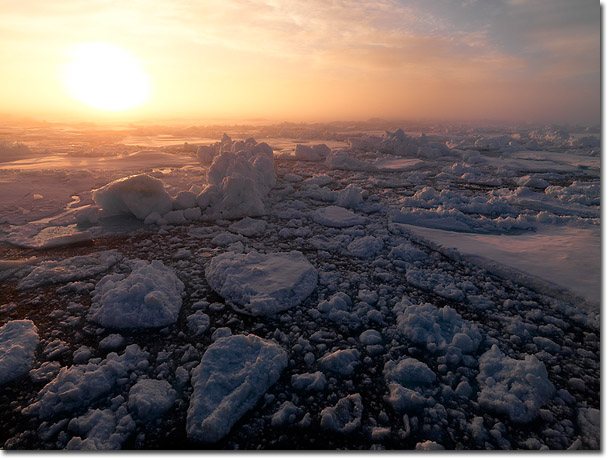
Pack Ice At Dawn / Hasselblad H3D-39, HC 28mm
One benefit to the absence of bona fide arctic weather was, occasionally, an astonishingly glassy sea. The combination of pack ice and surrounding mountains on several occasions eliminated any perceptible swell, transforming the water into a nearly flawless photographic mirror. While not busy admiring their own reflections, my cameras managed to capture scenery ranging in scope from grand landscapes to individual ice formations suspended like crystals in aquamarine translucence.
Wildlife
Many visitors expect the arctic to be teeming with wildlife, perhaps mislead by the vast colonies of penguins that populate the Antarctic. The reality is quite different. Much of the arctic wildlife is not only under pressure from global warming, but from extensive hunting by the locals. During two weeks at sea, we encountered polar bears, musk ox, seals, walrus, and arctic hare, but sightings were few and far between, and usually at distances not suitable for quality photography. The larger marine mammals rather consistently fled from potential human contact, exhibiting the very instincts that have undoubtedly enabled their survival to date. Ellesmere accordingly does not rate as a prime destination for wildlife photography, particularly when compared with better known regions such as Svalbard, Churchill, and parts of Alaska.
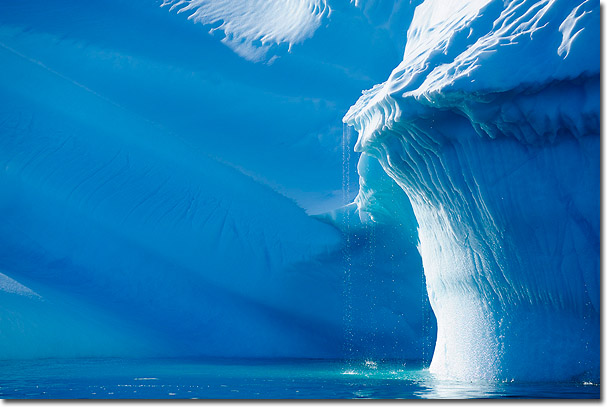
Melting Icescape / Nikon D700, 70-200mm at 200mm
Human Presence
The only permanent settlement on Ellesmere Island sits at its southern tip, in a place called Grise Fjord. This translates to “pig fjord” in Norwegian or, for those who find it more uplifting, the village goes by an Inuit name meaning “the place that never thaws out.” Grise Fjord’s 140 residents are Inuit subsistence hunters whose ancestors were involuntarily relocated by the Canadian government in 1953, as part of a program designed to bolster claims to far northern lands. Most of them live in squalor, in small dwellings often held together by patchworks of spare plywood, front yards littered with the rotting carcasses of seals, polar bears and narwhal – an interesting visual, but hardly the recipe for a landscape photography Mecca. Despite these conditions, the Inuit were exceedingly friendly, seemingly appreciative that guests from another realm provided a respite from the monotony of life at a place that never thaws out. Enthused by the visitors, one local mother went so far as to dress her three year old daughter, from head to toe, in a costume made from the fur of a local ring seal, i.e., as a polar bear snack. Traditions aside, that struck me as a parenting decision of questionable prudence, considering the prevalence of large white creatures known to roam the surrounding countryside.
Logistics
My voyage was aboard the Kapitan Khlebnikov, a diesel-electric icebreaker launched in 1980. The ship sailed out of Resolute Bay in Nunavut, Canada, a northern port reached through a five hour charter flight out of Ottawa. The Khlebnikov is built like a tank and provides a stable platform for photography, at least while not bouncing like a pinball through iceberg labyrinths. Conventionally powered, the ship routinely slices through sheets of ice up to one meter thick, a feat that continued to amaze even after several days of continual icebreaking. Some of its nuclear-propelled cousins are three times as powerful, enabling them to cut ice as thick as three meters while hauling passengers to the North Pole with relative ease.
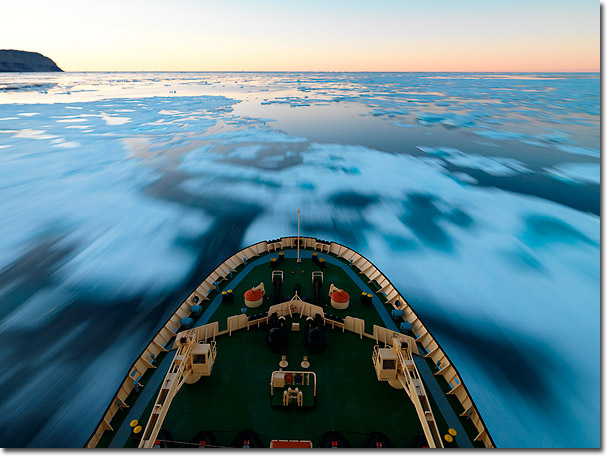
Breaking Ice / Hasselblad H3D-39, HC 28mm
Unfortunately, in 2012, the Khlebnikov will cease passenger operations, returning full-time to its original role of escorting merchant ships through ice-filled arctic waters. There are currently no plans for another icebreaker to take over the Khlebnikov’s passenger routes.
Conclusion
The difficulties associated with reaching and exploring Ellesmere Island were considerable. In the end, though, the voyage was easily a worthwhile investment. The journey yielded imagery of rarely visited landscapes in the midst of unprecedented transformation, accompanied by a sense of history that could never be gleaned without visiting these lands in person. Hopefully this small window into the Canadian arctic will inspire some of you to visit, and help safeguard, a landscape that may otherwise soon vanish.
Comments on NPN landscape photography articles? Send them to the editor. NPN members may also log in and leave their comments below.
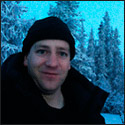 Ben Hattenbach is an avid adventurer, conservationist, and wilderness photographer. To the dismay of his wife, his idea of a good time usually involves exploring the most remote and inhospitable corners of our planet.
Among his favorite subjects are desolate arctic landscapes and the wildlife that inhabits them. He regularly ventures above the Arctic Circle in winter, most recently enduring temperatures of -65 degrees F while searching for an exceptional aurora over Alaska’s north slope. In more temperature climates he often backpacks many miles into the wilderness, in search of scenery unvisited by others.
Ben Hattenbach is an avid adventurer, conservationist, and wilderness photographer. To the dismay of his wife, his idea of a good time usually involves exploring the most remote and inhospitable corners of our planet.
Among his favorite subjects are desolate arctic landscapes and the wildlife that inhabits them. He regularly ventures above the Arctic Circle in winter, most recently enduring temperatures of -65 degrees F while searching for an exceptional aurora over Alaska’s north slope. In more temperature climates he often backpacks many miles into the wilderness, in search of scenery unvisited by others.
Most of Ben’s photographs are captured with a 39 megapixel medium format digital camera, yielding prints with exceptional detail and color. His images have been published worldwide in a variety of media, including recently in Outdoor Photographer and Popular Photography. Ben was named Hasselblad’s “Photographer Of The Month” for September 2010, and his work will be featured in Hasselblad’s Victor magazine in October 2010.
His portfolio of landscape imagery, and related writings, may be seen at www.benhattenbach.com. When not photographing faraway landscapes, Ben is a partner at a Los Angeles-based law firm where his practice focuses on the trial of complex intellectual property disputes.